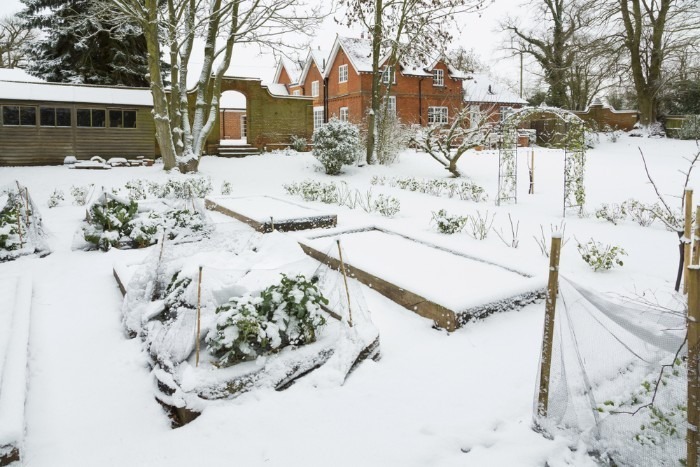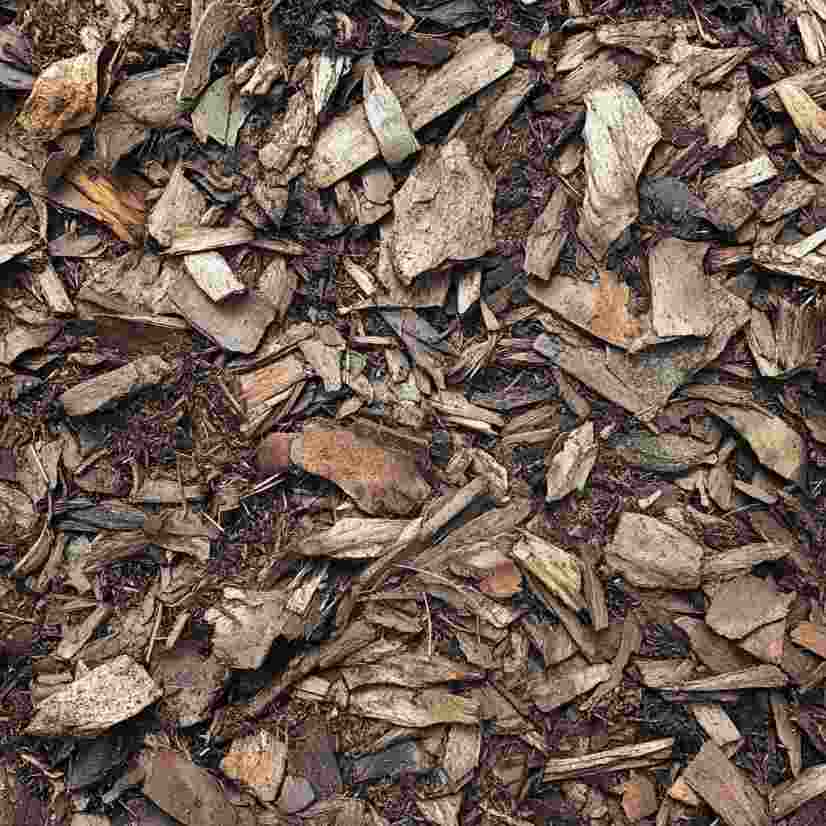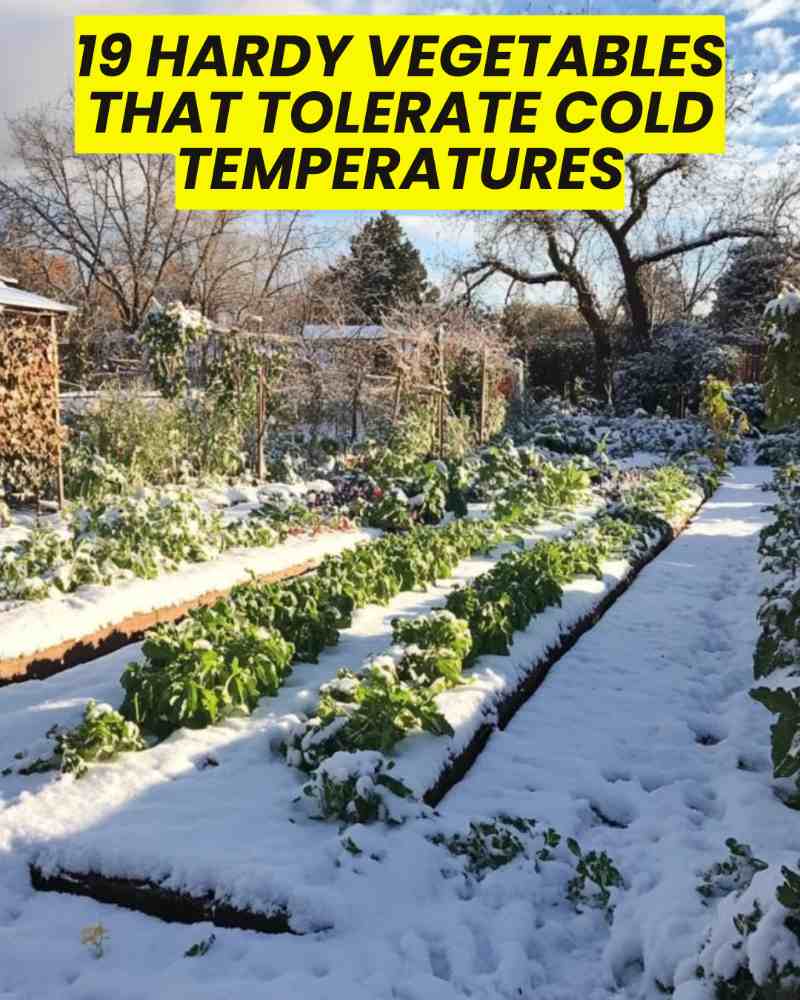19 Hardy Vegetables That Tolerate Cold Temperatures

Make sure to like Living Green and Frugally on Facebook, Shop at Amazon to help support my site and explore our PINTEREST BOARDS for innovative ways you can become self-sufficient.

2. Carrots
Carrots thrive in cooler weather, and they can remain in the ground even when temperatures drop, sweetening after a light frost. Plant them in the late summer for a fall harvest or overwinter them for early spring harvests.
3. Brussels Sprouts
Brussels sprouts love the cold, and just like kale, frost enhances their flavor. Plant them in mid-summer, and you’ll be harvesting sweet, crisp sprouts throughout the fall.
4. Spinach
Spinach is a quick-growing green that can be planted in early spring or late summer. It tolerates light frost and often survives until hard freezes arrive.
5. Leeks
Leeks are ideal for fall and winter harvesting. They thrive in cooler temperatures, and the white stalks will remain tender and flavorful even after frost.
6. Cabbage
Cabbage is another vegetable that benefits from a touch of frost, which sweetens its flavor. Cabbage can grow well into fall and is often harvested during the cooler months.
7. Garlic
While garlic is typically planted in the fall and harvested in the summer, it requires a cold period to develop properly. Frost doesn’t bother garlic, and it will grow underground all winter long.
8. Beets
Beets are a hardy root vegetable that, much like carrots, taste better after a frost. You can plant them in late summer for a fall harvest, and they can survive light frost with ease.
9. Swiss Chard
Swiss chard can tolerate cool weather, although it’s not as hardy as kale. It can be grown well into fall and will tolerate light frost before wilting in the extreme cold.
10. Parsnips
Parsnips are a root vegetable that, like carrots, sweeten with frost. You can leave them in the ground throughout the winter and harvest as needed.
11. Turnips
Turnips grow best in cool weather and can survive light frost. They’re ideal for fall planting, and both the roots and greens can be harvested during the colder months.
12. Radishes
Radishes mature quickly and thrive in cooler temperatures. They’re best planted in early spring or late summer for a fall harvest.
13. Onions
Onions are typically planted in the fall for a spring or summer harvest. They can survive frost and cold temperatures as they grow slowly over the winter.
14. Broccoli
Broccoli thrives in cool weather and can withstand frost. Plant it in late summer for a fall harvest, and you’ll enjoy fresh broccoli well into the cooler months.
15. Cauliflower
Cauliflower prefers cool temperatures and can survive light frosts. Plant it alongside broccoli and cabbage for a bountiful fall harvest.
16. Rutabaga
Rutabaga is a root vegetable that grows best in cool weather and can survive light frost. It’s a great crop for fall gardening.
17. Collard Greens
Collard greens, like kale, are cold-hardy and actually taste better after a frost. They are a staple of fall and winter gardens in many regions.
18. Mustard Greens
Mustard greens grow well in cooler temperatures and can withstand light frost. They’re perfect for planting in early spring or late summer.
19. Winter Lettuce
While most lettuce varieties prefer cool weather, some are bred specifically for winter gardening. Winter lettuce can survive light frosts and provides a fresh source of greens even when temperatures drop.

Tips for Growing Cold-Hardy Vegetables
1. Use Row Covers
Row covers are a great way to protect your vegetables from frost while still allowing light and air to reach them. They can extend your growing season by several weeks and help protect young plants from sudden temperature drops.
2. Mulch Heavily
Mulching around the base of your plants insulates the soil, protecting roots from freezing temperatures. Use straw, leaves, or compost as mulch for best results.
3. Choose Cold-Tolerant Varieties
Some varieties of vegetables are more cold-tolerant than others. When buying seeds or seedlings, look for ones labeled as “frost-resistant” or “cold-hardy” to ensure they can handle the chill.
4. Plan Your Planting Schedule
For fall gardening, start seeds indoors in mid-summer and transplant them outside as the weather cools. For spring gardening, plant seeds directly into the ground as soon as the soil can be worked, typically four to six weeks before the last frost date.
5. Water Wisely
Cold, dry air can cause plants to become dehydrated, so make sure they have enough water. However, avoid overwatering as this can lead to root rot, especially as the temperatures drop.

Common Questions About Cold-Weather Vegetables
Q: Can these vegetables survive snow and freezing temperatures?
A: Some of these vegetables, like kale, carrots, and Brussels sprouts, can survive under snow for short periods, and others, like leeks and garlic, overwinter well. However, most of them will need protection or harvesting before hard freezes.
Q: How do I know when to harvest cold-weather vegetables?
A: Many cold-hardy vegetables actually taste better after a frost. Root vegetables like carrots and parsnips can be left in the ground and harvested as needed, while leafy greens should be harvested before hard freezes to prevent damage.
Q: Can I grow these vegetables in containers?
A: Absolutely! Many of these cold-hardy vegetables grow well in containers, especially if you’re short on garden space. Just make sure to protect them from extreme cold by moving the containers to a sheltered area or using row covers.
Q: What’s the best time to plant cold-hardy vegetables?
A: For fall harvests, plant them in mid-to-late summer, depending on your region. For spring gardening, plant them as soon as the ground is workable, usually several weeks before the last frost.
Conclusion
Growing hardy vegetables that tolerate cold temperatures extends your gardening season and provides you with fresh, nutritious produce even in the colder months. By choosing the right crops, protecting them from frost, and knowing when to plant and harvest, you can enjoy a bountiful garden long after summer’s warmth has faded. Whether you’re a seasoned gardener or just getting started, cold-weather gardening can be a rewarding way to make the most of your outdoor space year-round. Happy gardening!
